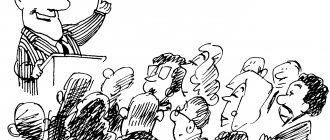- October 6, 2018
- Psychology of communication
- Valentina Buravleva
Communication is a special type of communication, which consists of exchanging information and organizing joint activities. The desire to interact with each other is inherent in humans by nature and is an integral part of their existence, because this is the most important component of life in society.
Why does communication require skill?
The very phrase “the art of communication” suggests that this term is understood as more than just one of the social functions. In order to successfully interact with other people, you need to have a certain skill. And someone has such skills perfectly; communication with such people becomes pleasant and easy. And some people fail to simply start a dialogue - for them the art of communication is a mysterious secret that has yet to be comprehended. From all this it follows that to conquer this science you need to know its basics and improve your skills, or in other words, learn. Mastery comes with experience, and experience is gained through constant practical training and self-improvement. The success of mastering the art of communication depends directly on the person himself. But there are several good ways that will definitely help you find a common language with any person.
Communicative personality.
Modern linguistics, communication theory, and almost all of the humanities are successfully developing a new approach to communicative activity—anthropocentric (focusing not on the system and structure, but on the user of language, communication and social systems—the person).
4 pp., 1628 words
Analysis of a person’s communicative competence
… This is a partial result of horizontal and vertical communication. An example of vertical communication is communication with teachers. She... Analysis of the norms of communicative behavior of a given individual. Indication of strengths and weaknesses. Recommendations. Communicative behavior of the younger ... and other means of communication (for example, ICQ), the appearance of communication often replaces communication in the true sense of the word. 2) ...
The concept of linguistic and communicative personality is introduced.
Depending on the way of using one’s communicative potential, a person can be classified as one type or another. We always unwittingly 'adapt' to the interlocutor in the process of communication, i.e. We carry out a metacommunicative function. An experienced communication specialist must constantly consciously perform this function (directing attention to the code and the communication process, correcting its progress).
One of the parameters 'under control' of a communicator is the type of interlocutor. What are the characteristics of the main types of communicators?
Maintaining eye contact
During a conversation, it is very important to create a trusting atmosphere around the interlocutor and a feeling of interest in the contact. Looking around will indicate uncertainty. And the person with whom the dialogue is being conducted is unlikely to open up for an active conversation, and there can be no talk of any art of communication in this case.
If direct gaze is unnecessarily embarrassing or causes a nervous chuckle, you can use the following technique: look at the area between the interlocutor’s eyebrows. This way it will be possible to commit a “deception” in which the “victim” will observe a direct “eye to eye” look.
The role of barriers in effective communication and how to overcome them
Communication barriers prevent our messages from reaching the other person's mind or distort them so that they lose their original meaning and message. There are many barriers that can impede effective communication, including physical (distance, noise, etc.), physiological (hearing or speech impairment), sociocultural (cultural differences), semantic (signs and symbols) or, in fact, linguistic.
Other factors that can act as barriers include environment, stress, context, interference, emotional imbalance, lack of interest or focus, inconsistent body language, etc.
Obstacles to effective communication can be overcome through the right means—using shorter sentences, better organizing your message before sending it, training, being empathetic and mindful, avoiding prejudice, information noise, etc.
Showing interest
One who masters the art of communicating with people always pays close attention to the personality of his interlocutor. Without this, successful communication is impossible. Even if you cannot yet express your interest in the conversation properly, you should try your best to do so. Over time, you will hone your communication skills, and asking your interlocutor the right questions about himself and the things that are important to him will become much easier.
You also need to learn to show interest in your counterpart because it is always very difficult to listen to the monotonous speeches of one person. Therefore, it is worth trying to transform such monologues into dialogues: be surprised by the interlocutor’s statements, play with emotions, ask questions. In general, hone your art of communication, doing everything to ensure that communication develops and becomes more and more relaxed, and those in contact feel comfortable.
Working on your speech
In order for the dialogue to be pleasant and for the interlocutors to listen to each other comfortably, it is very important to observe your speech and develop eloquence. Anyone who uses monosyllabic phrases will not be able to take an active position in the conversation. On the contrary, someone who masters the art of successful communication, competently expresses his thoughts, diluting his speech with various constructions, turns of phrase and means of expression, will always be pleasant to people and popular in society. Reading, listening, speaking - these are the keys to rapidly enriching the language and winning the attention of other participants in the discussion.
Criteria for business communication
The image of a business person, which includes the psychology of successful communication, is based on decency and compassion.
Thus, the model of his behavior can be considered:
- Respect for yourself and your partners, showing delicacy, tolerance, and tact in conversations;
- Recognition of the role of communication not only for business contacts, but also for cooperation;
- Avoiding overconfidence;
- Ability to listen to people;
- Politely rejecting unnecessary topics;
- Lack of confusion and uncertainty.
For the psychology of effective communication, there are several levels that determine its mastery. This is freedom, which implies high compatibility, flexibility and contact; active leadership demonstrating courage and dignity; a partner level that allows you to listen to an idea and find the best solution. Sociability is directly related to a person’s benevolent emotional state, which ensures ease and ease of acquaintance and communication.
Applying a mirror effect
Gesticulation allows words to acquire more persuasiveness and a certain charm, and the speaker to become more emotional in the eyes of the interlocutor (however, during the moments of its reproduction, it is important to remain calm so as not to look too excited). The "mirror" effect is to repeat the movements and intonation of your opponent. This technique is often used by those who master the art of business communication. For example, you can easily win over a potential business partner by unobtrusively “mirroring” his posture.
Developing Confidence
Most often, confident people attract the attention of others with their charisma. The art of successful communication is largely determined by the presence of high self-esteem. Such people are always noticed in the crowd. They are bright, and others see in them what they themselves lack. Naturally, the art of communication is never easier for such individuals. After all, with their entire appearance they inspire confidence in people, and are also an example of reliability. Developing self-confidence is the path to leaving good impressions on your interlocutors.
Psycho-social and environmental factors in effective communication
Effective communication is the ability to appropriately address another person's social and cultural background. If the social and cultural background of the interlocutors is different, their messages will not be interpreted properly, since the social reality of both will be at different levels.
Context or environment also influences the effectiveness of communication as people should not laugh when someone is crying. The position should always complement the situation. Effective communication is when social, cultural or environmental factors are used to influence people and convey clear messages to them.
Practical Methods for Developing Confidence
How can you become a more confident person? The main methods recommended by many psychologists are as follows:
- Thought control. A person has about 65,000 thoughts per day. But 80-90 percent of them are negative - these are either worries, or worries, or warnings. Psychologists emphasize that these fears make a person more cautious and therefore cannot be unequivocally assessed in a negative way. But modern human life, for the most part, is not fraught with danger. Once you realize that these are just anxious thoughts, you can become much more confident.
- Have a goal. A confident person always knows what he wants from life. Knowing your purpose is the key to success.
- Start your morning with gratitude. This will allow you to tune in to a positive mood. If you start the day with gratitude, you can maintain a good mood until the evening.
- Leave your comfort zone. Communication can really make a person afraid. Most often, this reaction is due to past experiences. But in order to become more confident, you need to form a new attitude in yourself: to realize that communication could be unpleasant and dangerous in the past, and in the current situation there is absolutely nothing to be afraid of. This can only be done by accepting the challenge and entering into dialogue even when you don’t particularly want to do so.
- Workout. Language of communication is an art that includes not only verbal communication. It is also important in constructing a dialogue how a person behaves, what kind of posture he has, how he presents himself. Physical exercise and sports make you feel much more alert, which can’t help but affect your confidence.
- Choose the right environment. If you are constantly around those people who devalue you, most likely this will affect your self-esteem in the most negative way. It is believed that each person is the arithmetic mean of the 5 people around her. Therefore, you need to be careful about your surroundings.
- Feeling of openness. Openness testifies to honesty, and honest people always create an aura of correctness and nobility around themselves and inspire trust. Openness is also acceptable when the interlocutors are close enough that the conversation should be simplified so that the participants in the conversation open up to each other and feel even more comfortable. However, this advice should only be used if people are willing and trustworthy to share personal information. There is no need to share your secrets with strangers. Otherwise, it will have the opposite effect and alienate others. And even if the chances of a good acquaintance were great, then if you are too frank in the initial stages of communication, you can ruin a potential friendship.
Other techniques
Communication is also an important part of psychology and exists and develops according to its laws. It is important for people to exchange information that includes their opinions, experiences, joys and sorrows. However, not everyone manages to understand the politics of communication and how best and on what basis it is worth expressing their views and opinions. In this case, there is nothing wrong with resorting to some psychological techniques that can help the interlocutors “liberate” the conversation, make it more pleasant and easier, and in some situations, get specific information from the opponent. There are other ways to improve your people skills:
- The very beginning of communication should always be positive. This will set the tone for the entire conversation.
- If someone lied or said an unpleasant thing, you should not argue. You can simply look a person in the eyes with expression, and he will be forced to continue the conversation.
- When meeting someone, try to consider the color of the person's eyes. This will allow you to concentrate on the interlocutor.
- By expressing sincere joy at a meeting, you can receive the same positive emotions in return.
- During times of strong excitement, you can chew gum. This causes associations in the brain with eating - and therefore with peace.
In the course of development, humanity observed its actions and formed a science that is able to explain and predict them - psychology. Putting the above methods into practice will help not only improve communication, but also direct the conversation in the direction you want.
What are “personal boundaries”?
For me, the concept of “personal boundaries” includes the fact that I would not want to do to someone what would be unpleasant to me. But all people have such different concepts of personal boundaries. What is it really?
A personal boundary is a line that should not be crossed! The border is the border! If you go in, it means you will disrupt, and sometimes break off, relationships forever. And this is always painful!
Our personal boundaries always begin with our body, and we begin to feel this from childhood. Physical punishment, gross invasion of personal space (for example, reading a diary with personal notes), violation of privacy, psychological violence in the form of insults, shouting, disrespect at any age, offensive jokes and ridicule, etc., all this greatly affects our understanding personal boundaries, parents are especially guilty of this (we recommend an article about separation from parents).
All this hits self-esteem very hard, especially if the power of parents is very strong. The child initially tries to defend his boundaries, but he is often stopped, sometimes for no reason at all. Parents manipulate the child, causing feelings of guilt and shame.
As adults, our body and brain remember our behavior “from childhood,” and then we live like this, when our boundaries are constantly violated. And we accept it without complaint until our patience breaks and a “war” breaks out, sometimes with the closest people over our personal boundaries.
Advice . Do not tolerate violation of your personal boundaries, cut off immediately and say what you don’t like. You need to talk about your needs and feelings right away. This sets the rules of communication and marks boundaries.











